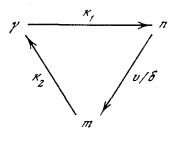Institute of Biological Physics, the USSR Academy of Sciences, Pushchino, Moscow Region, USSR
Summary: A mechano-chemical approach to the choice of characteristic variables for the description of the cross-bridge states in active muscle is proposed. A small number of mechanically significant states of the cross-bridge should be postulated to obtain an informative model of the cross- bridge contractile cycle. There exist two simplest models which are capable to describe a variety of experimental data on muscle contraction. In the «kinetic» model /V. I. DESCHEREVSKIĬ, Biorheology 7, 147 (1971)/ two mechanically significant states of the cross-link are postulated in which it develops constant positive («pulling» state) and negative («hindering» state) forces independent of the velocity of contraction. In the alternative model suggested by CHAPLAIN and FROMMELT and independently by BURAVCEV only one mechanically significant state is postulated in which the cross-link develops a positive force linearly decreasing with the speed of contraction. Near the steady-state conditions both models are mathematically equivalent, but under sharply non-stationary conditions their behavior differs essentially. Transient responses of muscle to step-like change allow to decide between the models. It is concluded that the steady-state velocity of unloaded contraction cannot be limited by the cross-link inherent «friction», as results from the second model, but it can be limited by a hindering force of potential nature such as postulated in the «kinetic» model. The relation between the postulated significant states of the cross-bridge and its actual molecular transitions in active muscle is discussed.

Comments are closed, but trackbacks and pingbacks are open.